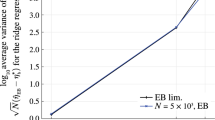Abstract
An iterative identification and control design method based on υ-gap is given to ensure the stability of closed-loop system and control performance improvement. The whole iterative procedure includes three parts: the optimal excitation signals design, the uncertainty model set identification and the stable controller design. Firstly the worst case υ-gap is used as the criterion of the optimal excitation signals design, and the design is performed via the power spectrum optimization. And then, an uncertainty model set is attained by system identification on the basis of the measure signals. The controller is designed to ensure the stability of closed-loop system and the closed-loop performance improvement. Simulation result shows that the proposed method has good convergence and closed-loop control performance.
Similar content being viewed by others
References
Lecchini A, Lanzon A, Anderson B D O. A model reference approach to safe controller changers in iterative identification and control. Automatica, 2006, 42(2): 193–203
Bazanella S, Gevers M, Mickovic L. Iterative minimization of H 2 control performance criteria. Automatica, 2008, 44(10): 2549–2559
Hjalmarsson H, Jansson H. Closed loop experiment design for linear time invariant dynamical systems via LMIs. Automatica, 2008, 44(3): 623–636
Bitmead R, Zang Z. An iterative identification and control strategy. In: Proceedings of European Control Conference, Grenoble, France: EUCA, 1991. 1395–1400
Partanen A G, Bitmead R. The application of an iterative identification and controller design to a sugar cane crushing mill. Automatica, 1995, 31(8): 1547–1563
Callafon R A DE, Van Den Hof P M J. Suboptimal feedback control by a scheme of iterative identification and control design. Math Model Syst, 1997, 3(1): 77–101
Holmberg U, Valentinotti S, Bonvin D. An identification for control procedure with robust performance. Contr Eng Pract, 2000, 8(10): 1107–1117
Date P, Lanzon A. A combined iterative scheme for identification and control redesigns. Int J Adapt Control Signal Proc, 2004, 18(8): 629–644
Li T, Georgakis C. Dynamic input signal design for the identification of constrained systems. J Proc Control, 2008, 18(3-4): 332–346
Lindqvist K, Hjalmarsson H. Identification for control: adaptive input design using convex optimization. In: Proceedings of the 40th IEEE Conference on Decision and Control, Oriando, Florida USA, 2001. 4326–4331
Jansson H, Hjalmarsson H. Input design via LMIs admitting frequency-wise model specifications in confidence regions. IEEE Trans Autom Control, 2005, 50(10): 1534–1549
Bombois X, Scorletti G, Gevers M, et al. Least costly identification experiment for control. Automatica, 2006, 42(10): 1651–1662
Vinnicombe G. Frequency domain uncertainty and the graph topology. IEEE Trans Autom Control, 1993, 38(9): 1371–1383
Gevers M, Bombois X, Codrons B. Model validation for control and controller validation in a prediction error identification framework. Part II: Illustrations. Automatica, 2003, 39(3): 417–427
Bombois X. Connecting prediction error identification and robust control analysis: A new framework. Dissertation for Doctoral Degree. Belgium: University of Catholique de Louvain, 2000. 42–50
Hildebrand R, Gevers M. Minimizing the worst-case υ-gap by optimal input design. In: Proceedings of 13th IFAC Symposium on System Identification, Rotterdam, The Netherlands, 2003. 665–670
Zong Q, Dou L Q, Sun L K. Iterative excitation signal design for closed-loop system identification (in Chinese). Syst Eng Electr, 2008, 30(8): 1530–1534
Jansson H. Experiment design with applications in identification for control. Dissertation for Doctoral Degree. Sweden: Royal Institute of Technology, 2004. 152–165
Dehghani A, Lanzon A, Anderson B D O. An H ∞ algorithm for the windsurfer approach to adaptive robust control. Int J Adapt Control Signal Proc, 2004, 18(8): 607–626
Author information
Authors and Affiliations
Corresponding author
Additional information
Supported by the National Natural Science Foundation of China (Grant Nos. 60574055, 60874073), the Specialized Research Fund for Doctoral Program of Higher Education of China (Grant No. 20050056037), and the Tianjin Science and Technology Keystone Project (Grant No. 08ZCKFJC27900)
Rights and permissions
About this article
Cite this article
Dou, L., Zong, Q., Zhao, Z. et al. Iterative identification and control design with optimal excitation signals based on υ-gap. Sci. China Ser. F-Inf. Sci. 52, 1120–1128 (2009). https://doi.org/10.1007/s11432-009-0105-x
Received:
Accepted:
Published:
Issue Date:
DOI: https://doi.org/10.1007/s11432-009-0105-x




